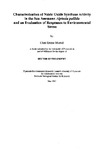Characterisation of Nitric Oxide Synthase Activity in the Sea Anemone Aiptasia pallida and an Evaluation of Responses to Environmental Stress
| dc.contributor.author | Morrall, Clare Emma | |
| dc.contributor.other | Faculty of Science and Engineering | en_US |
| dc.date.accessioned | 2013-10-22T10:52:01Z | |
| dc.date.available | 2013-10-22T10:52:01Z | |
| dc.date.issued | 2003 | |
| dc.identifier | NOT AVAILABLE | en_US |
| dc.identifier.uri | http://hdl.handle.net/10026.1/2282 | |
| dc.description.abstract |
Studies were undertaken to investigate the presence of nitric oxide synthase (NOS; E.C. 1.14.13.39) activity in number of cnidarian species from shallow marine subtropical environments. Enzyme activity was assayed by measuring the conversion of 3H L-arginine to 3H L-citrulline (the citrulline assay). This assay was shown to be sufficiently sensitive for studies of this nature but was not optimised for use with cnidarian preparations. As a result, confidence in the accuracy of the generated assay results is limited. NOS activity was nevertheless demonstrated in the sea anemone A. pallida, in the zooxanthellae associated with A. pallida, Symbiodinium spp. and in five scleractinian coral species. Preliminary studies were conducted to characterise NOS from A. pallida. NOS activity of this species was shown to be predominantly cytosolic and basal rates of enzyme activity were determined to be 0.47 ±0 - 9.96 ±0.06 pmoles citrulline µg proteinˉ¹ minˉ¹. The biochemical signature of the enzyme is defined by an apparent Km of 132.9 µM L-arginine and an apparent V max of 17.7 pmoles citrulline µg proteinˉ¹ minˉ¹. The NOS enzyme from A. pallida was inhibited by the arginine analogue L-NMA with an apparent K1 of 1014 µM. Histochemical localisation of NOS activity by NADPH-diaphorase staining showed the enzyme to be present in the epidermal cells and at the extremities of the mesoglea. The hypothesis that NOS has potential as an innovative biochemical effect biomarker in cnidarian species was investigated with a number of experiments. NOS activity levels were determined in A. pallida previously dosed with sublethal concentrations of copper, fluoranthene or tributyltin-oxide. No clear evidence to support this hypothesis was provided by these studies. Morphological responses of A. pallida were monitored during exposure to contaminants, arginine analogues, a nitric oxide donor and a thermal regime that induced bleaching. Contraction of tentacles and body columns was a noted response to each of these exposures; individuals exposed to the most extreme concentrations of chemicals or the highest temperature tested typically elicited the most extreme contraction responses. Exposure of A. pallida to temperatures gradually increasing from 25 to 35°C over 10 days induced bleaching characterised by reduced zooxanthellae densities. NOS activity levels and antioxidant capacity, both expressed in terms of per unit protein, were increased in anemones exposed to temperatures of > 31 °C. NOS and FRAP activities expressed on a per anemone basis showed no clear change over the experimental period despite the substantial declines in host protein noted in anemones over the experimental period. These results indicate that FRAP and NOS activity levels were maintained over the course of the applied experimental thermal regime despite the occurrence of dramatic physiological changes. Taken together, these results suggest that NOS plays an important role in the biology of cnidarians, and that as such, the activity of this enzyme has the potential to be developed into a valuable biomarker for the evaluation of initial responses of key organisms in tropical and subtropical marine ecosystems to adverse conditions. However, these results also reveal that a more comprehensive knowledge of both the roles played by NO and the responsiveness of NOS to a range of potentially adverse stimuli is required to fulfil this potential. | en_US |
| dc.description.sponsorship | Bermuda Biological Station for Research | en_US |
| dc.language.iso | en | en_US |
| dc.publisher | University of Plymouth | en_US |
| dc.title | Characterisation of Nitric Oxide Synthase Activity in the Sea Anemone Aiptasia pallida and an Evaluation of Responses to Environmental Stress | en_US |
| dc.type | Thesis | |
| dc.identifier.doi | http://dx.doi.org/10.24382/4910 |
Files in this item
This item appears in the following Collection(s)
-
01 Research Theses Main Collection
Research Theses Main


